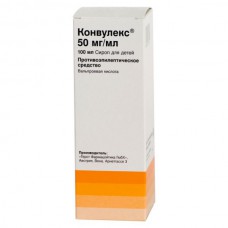Expiration date: 12/2026
Structure and Composition:
Syrup for children. 100ml contains valproic acid 4.338 g
Excipients: sodium hydroxide, sodium lycasin 80/55 saccharin, sodium cyclamate, sodium methyl hydroxybenzoate propyl chloride raspberry flavoring (9/372710) and peach (9/030307) purified water
in bottles of 100 ml, complete with a measured syringe in box 1 set.
Drops for oral administration. 1 ml contains valproic acid 300 mg
Other ingredients: Purified water
in bottles of 100 ml per box 1 bottle.
The tablets of the prolonged action covered with a cover. One tablet contains valproic acid 300 or 500 mg
Excipients: citric acid monohydrate, ethyl cellulose, Eudragit RS30D talc purified silica colloidal anhydrous magnesium stearate Eudragit L30D carmellose sodium dibutyl phthalate Macrogol 6000 titanium dioxide, vanillin simethicone
in polyethylene bottles or dark glass bottles of 50 or 100 pieces. in a cardboard bundle one bottle
Description pharmaceutical form:
Syrup for children: colorless or slightly yellow syrup, peach aroma and a sweet peach flavor.
Drops for intake: colorless or slightly yellow solution.
The tablets of the prolonged action covered liner: oval, biconvex tablets of white color, with the smell of vanilla, film-coated, with Valium and engraving «CC3» (300 mg tablet) or «CC5» (tablets of 500 mg) on ??one side in cross section white.
Characteristic: Antiepileptics.
Pharmacokinetics:
Quickly and completely absorbed from the digestive tract, bioavailability of 100%. Food intake does not reduce the rate of absorption. Cmax is defined through 3-4 h. The equilibrium concentration is reached 2-4 days of treatment (depending on the dosing intervals). Therapeutic plasma concentration - 50-150 mg / l. Binding to plasma proteins is 90-95% at a concentration in plasma of up to 50 mg / l and 80-85% at a concentration of 50-100 mg / l with uremia, hypoproteinemia cirrhosis and reduced protein binding. Concentrations in cerebrospinal fluid correlate with the unrelated protein fraction of the drug. Valproic acid crosses the placental barrier, excreted in breast milk. Concentration in breast milk is 1-10% concentration in maternal blood plasma. The drug undergoes glucuronidation and oxidation in the liver metabolites and unmodified valproic acid (1-3% of the dose) excreted by the kidneys, small quantities - with feces and expired air. T1 / 2 in healthy subjects and in monotherapy - 8-20 hours, in combination with inducers of metabolic enzymes T1 / 2 - 6-8 hours in patients with hepatic impairment and elderly patients can significantly lengthen.
Prolonged absorption of the shape is characterized by a slow, lower (25%), but relatively more stable plasma concentration between 4 and 14 hours.
Description of the pharmacological actions:
It inhibits GABA-transferase and increases the content of GABA in the CNS. GABA inhibits pre- and postsynaptic discharges and thereby prevent the spread of seizure activity in the CNS. In addition, the mechanism of action of the drug plays a significant role in the effects of valproic acid GABA A receptors, as well as the impact on voltazhzavisimye sodium channels. According to another hypothesis, it acts on sites of postsynaptic receptors, mimicking or enhancing the inhibitory effect of GABA. Possible direct effect on the activity of the membrane due to changes in potassium conductance. It improves mood and mental state of patients has anti-arrhythmic activity.
Indications:
- epilepsy of any origin
- epileptic seizures (including generalized and partial, as well as against the background of organic brain disease)
- disorder and behavior associated with epilepsy
- febrile seizures in children
- manic-depressive syndrome with bipolar course, not amenable to treatment with drugs lithium and other drugs.
Contraindications:
- hypersensitivity
- expressed human liver and / or pancreas
- porphyria
- severe thrombocytopenia
- bleeding diathesis
- pregnancy (I trimester)
- breast-feeding
- Children up to age 3 years (tablet).
Application of pregnancy and breastfeeding:
During treatment should avoid pregnancy.
In experiments on animals showed teratogenic effects of valproic acid. The incidence of neural tube defects in babies born to women who took valproate in the I trimester of pregnancy is 1-2%. It is expedient in this connection the use of folic acid.
If a pregnant woman is already receiving the drug, in connection with the risk of increased frequency of seizures the treatment should not be interrupted. The drug should be used in the smallest effective dose, avoiding combination with other anticonvulsants and, where possible, regular monitoring drug levels in plasma.
When lactation the drug should be taken with caution. However, breast-feeding is possible, since concentration in the milk does not exceed 1.10% of the plasma level of the drug in the mother's blood.
Side effect:
In general, Convulex well tolerated. Side effects are possible mainly at the level of the drug in the plasma over 100 mg / l, or in combined therapy.
From the digestive tract: nausea, vomiting, gastralgia, anorexia or increased appetite, diarrhea, hepatitis rarely - constipation, pancreatitis, down to heavy defeats fatal (in the first 6 months of treatment, often at 2-12 weeks).
CNS: tremor rare - changes in behavior, mood or mental state (depression, fatigue, hallucinations, aggression, hyperactivity condition, psychosis, unusual excitement, restlessness or irritability), ataxia, dizziness, drowsiness, headache, encephalopathy, dysarthria , stupor, impaired consciousness, coma.
From the senses: diplopia, nystagmus, flashing "flies" in front of his eyes.
From the side of hematopoiesis and hemostasis system: anemia, leukopenia, thrombocytopenia, decreased fibrinogen, platelet aggregation and blood clotting, accompanied by a prolonged bleeding time, petechiae, bruising, hematoma, bleeding and others.
From a metabolism: a decrease or increase in body weight.
Allergic reactions: skin rash, urticaria, angioedema, photosensitivity, Stevens-Johnson syndrome.
Laboratory findings: hypercreatininemia, hyperammonemia, hyperbilirubinemia, a slight increase in activity of "liver" transaminases, LDH (dose-dependent).
From endocrine system: dysmenorrhea, secondary amenorrhea, breast enlargement, galactorrhea.
Other: peripheral edema, hair loss (usually cease after discontinuation of the drug).
Drug Interactions:
Pharmacodynamic interactions
With simultaneous use of valproic acid, ethanol and other drugs, oppressive central nervous system, may increase CNS depression. Ethanol and other hepatotoxic medications increase the likelihood of developing liver disease. Tricyclic antidepressants, MAO inhibitors, neuroleptics and other drugs that reduce the seizure threshold activity, reduce the effectiveness of valproic acid.
Convulex enhances the effects, including side, other antiepileptic drugs (phenytoin, lamotrigine), antidepressants, antipsychotics, tranquilizers, barbiturates, MAO inhibitors, ethanol. Adding valproate to clonazepam in rare cases can lead to increased severity of absence status.
Pharmacokinetic interactions
With simultaneous use of valproic acid, barbiturates or primidone marked increase in their concentration in blood plasma. Increases T1 / 2 Lamotrigine (inhibit liver enzymes, slows down the metabolism of lamotrigine thereby T1 / 2 of its extended to 70 hours for adults and up to 45-55 h - children). AZT reduces clearance by 38%, while it T1 / 2 does not change.
In combination with salicylates observed amplification effects of valproic acid (the displacement of its association with plasma proteins). Convulex enhances the effect of antiplatelet agents (aspirin) and anticoagulants.
In combination with phenobarbital, phenytoin, carbamazepine, valproic acid, mefloquine reduced serum content (metabolism acceleration).
Felbamate increases the concentration of valproic acid in plasma by 35-50% (required dose adjustment).
Valproic acid does not cause induction of liver enzymes and does not reduce the effectiveness of oral contraceptives.
Dosage and administration:
Inside.
Capsules: not liquid, regardless of the meal, with a small amount of liquid, 2-3 times a day.
The syrup and drops: independently from a meal, with a small amount of liquid, 2-3 times a day.
Tablets: not liquid, regardless of the meal, with a small amount of liquid, 1-2 times a day.
For adults, the initial daily dose - 600 mg, with a gradual increase in the dose every 3 days until a clinical response (disappearance of seizures).
Monotherapy initial dose - 5-15 mg / kg / day, then gradually increase the dose of 5-10 mg / kg per week.
The average daily intake - about 1000-2000 mg / day, ie, 20-30 mg / kg. If necessary, the dose was increased to 2500 mg / day.
The maximum dose - 30 mg / kg / day (may be increased if possible oversight for the plasma concentration to 60 mg / kg / day).
In combination therapy - 10-30 mg / kg / day, followed by increasing doses of 5-10 mg / kg per week.
Children weighing more than 25 kg, the initial daily dose - 300 mg (regardless of body mass), may be gradually increased until clinical effect is reached (disappearance seizures) 20-30 mg / kg per day. Initial dose monotherapy - 5-15 mg / kg / day, then gradually increased to 5-10 mg / kg per week. The maximum dose of 30 mg / kg / day (may be increased if possible oversight for the plasma concentration to 60 mg / kg / day).
Children weighing 17-25 kg (tablets) 7,5-25 kg (capsules, syrup, drops): the average daily monotherapy dose - 15-45 mg / kg, the maximum - 50 mg / kg. In the combination therapy - 30-100 mg / kg / day.
Mean daily dose - see table..
Table. Mean daily dose Convulex
| the child's body weight, teenager or adult, kg | Dose mg / day | The number of capsules (150 mg) | The number of capsules or tablets (300 mg) | The number of capsules or tablets (500 mg) | The amount of syrup ml | The number of drops |
| 7,5–14 | 150–450 | 1–3 | 3–9 | 15–45 | ||
| 14–21 | 300–600 | 2–4 | 1–2 | 6–12 | 30–60 | |
| 21–32 | 600–900 | 4–6 | 2–3 | 12–18 | 60–90 | |
| 32–50 | 900–1500 | 3–5 | 2–3 | |||
| 50–90 | 1500–2500 | 3–5 |
Elderly and patients with renal insufficiency can assign lower doses of the drug (requires careful selection of the dose).
Overdose:
Symptoms include nausea, vomiting, dizziness, diarrhea, breathing function, muscular hypotonia, hyporeflexia, miosis, coma.
Treatment: gastric lavage (no later than 10-12 hours), the appointment of activated carbon, dialysis, forced diuresis, maintenance of respiration and cardiovascular system.
Precautionary measures:
With caution is prescribed for anamnestic data on diseases of the liver and pancreas, bone marrow lesions, renal dysfunction, congenital enzimopaty, organic brain lesions, hypoproteinemia, in mentally retarded children.
Special instructions:
During treatment is appropriate control activity of "liver" transaminases, bilirubin, peripheral blood, blood platelets, blood coagulation status, amylase activity every 3 months (especially in combination with other antiepileptic drugs).
Patients, who receive other antiepileptics, transfer to valproic acid should be gradual, reaching a clinically effective dose after 2 weeks, then the possible phasing out of other antiepileptics. In patients who did not receive treatment with other antiepileptic drugs, clinically effective dose should be achieved after 1 week.
The risk of side effects from the liver increased during the combined anticonvulsant therapy and in children.
In the period of treatment should refrain from activities potentially hazardous activities that require high concentration and psychomotor speed reactions.
It is not allowed reception drinks containing ethanol.
Before surgery requires complete blood count (including platelet count), the determination of bleeding time, coagulation parameters.
In the event during the treatment of symptoms of "acute" abdomen prior to surgery is recommended to determine the level of amylase in the blood for elimination of acute pancreatitis.
During treatment should take into account the possible distortion of the results of urine tests for diabetes mellitus (due to increased content ketoproduktov), ??indicators of thyroid function.
With the development of any acute severe side effects you should immediately discuss with your doctor the advisability of continuing or stopping treatment.
To reduce the risk of dyspepsia can receive antispasmodics and enveloping means.
Sudden discontinuation of Konvuleks may lead to more frequent epileptic seizures.
Storage conditions:
Containers Keep container tightly closed.





